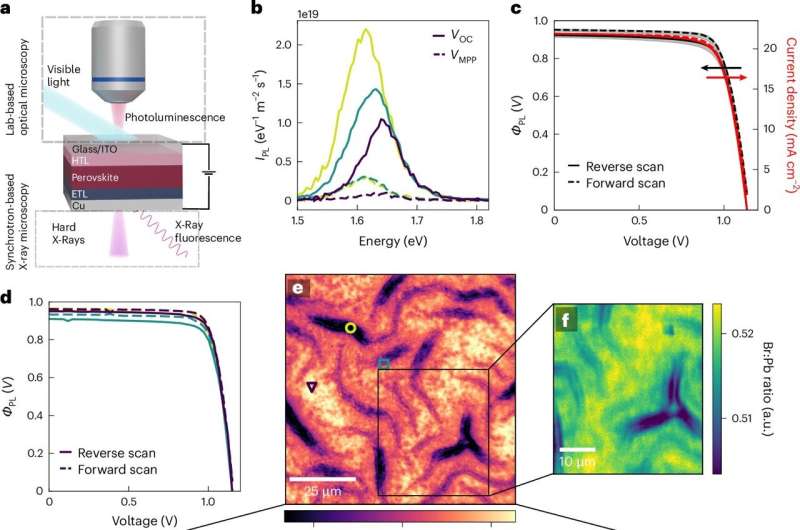Study introduces new approaches to engineer stable and robust perovskite solar cells
Perovskites are materials with advantageous optoelectronic properties that could be used to develop more affordable photovoltaics (PVs). While in recent years engineers were able to significantly improve the power-conversion efficiencies of perovskite solar cells, these devices remain less stable and scalable than conventional silicon-based solar cells.
Researchers at University of Cambridge, Helmholtz-Zentrum Berlin für Materialien und Energie GmbH and Diamond Light Source used optical and X-ray microscopy to better understand the nanoscale processes that impact the performance and degradation of solar cells based on halide perovskites.
Their paper, published in Nature Energy, demonstrates that microscale variations in composition, recombination and charge transport can impact the performance and stability of these solar cells, while also outlining approaches that could mitigate these effects.
“Our recent work focused on halide perovskite solar cells for applications in next-gen solar cells—these materials are highly disordered on microscopic length scales,” Samuel D. Stranks, senior author of the paper, told Tech Xplore. “In our previous works, we showed that microscopic variations in the atomic structure and chemical composition can impact the material properties of perovskite thin-films.”
Solar cells made fully of perovskites contain more than just a perovskite film, as they also contain layers of materials that extract and transport electrons and holes. These additional layers add complexity to the solar cells, as they could also contribute to losses in current and voltage, thus adversely impacting a cell’s overall performance.
“We wanted to augment our previous expertise by developing a multi-modal microscopy toolkit to probe voltage and current losses, their interactions with structural and chemical variations, in complete, state-of-the-art perovskite solar cells,” said Miguel Anaya, another senior author on the paper formerly of Cambridge and now based in Seville.
“Our objective was to understand this microscopic interplay to boost the performance and long-term durability of these devices.”
The microscopy toolkit was developed by a research team spearheaded by Kyle Frohna and Cullen Chosy. This toolkit which they used to closely examine perovskite solar cells as part of their recent studies, contains a variety of techniques. This broad range of methods can be roughly categorized into optical microscopy and X-ray microscopy techniques.
“On the optical side, we performed hyperspectral luminescence microscopy, which tracks the color and intensity of light emitted by the perovskite when a light source (e.g., a laser) illuminates the material,” explained Frohna.
“Carefully tracking the emitted fluorescence allows us to track microscopic voltage losses in the solar cell. We additionally perform voltage-dependent luminescence microscopy—which allows us to track local charge transport and current losses.”
On the other hand, the main X-ray microscopy technique employed by Stranks and his colleagues is known as nano X-ray fluorescence. This is an imaging method that allows researchers to gather more information about the chemical composition of a material.
The team used their comprehensive microscopy toolkit to study a wide range of perovskite solar cells. This allowed them to better understand how these cells’ current and voltage losses are influenced by chemical changes and how the parameters they focused on shifted after the cells were operating for long periods of time.
“We showed that perovskite solar cells can tolerate substantial microscopic chemical variations, which is something very different to conventional solar cells like silicon,” said Chosy.
“We also showed that they cannot tolerate variations in charge extraction. The messier the current is microscopically, the worse the solar cell performs—and even more strikingly, this messiness also results in the solar cells degrading considerably more quickly over time.”
In addition to outlining factors that influence the performance and stability of perovskite-based solar cells at a nanoscale, the researchers outlined approaches that could help to reduce the current losses they observed. As part of their next studies, Stranks and his colleagues plan to continue building on their toolkit, while also trying to use it to improve the long-term performance of perovskite PVs.
“Solar cells experience a wide range of conditions—extremely hot to extremely cold temperatures, forward and reverse bias conditions, intense and weak sunlight—the way that perovskite solar cells handle all of these conditions affects how long they will last,” added Stranks.
“We want to understand how these stresses affect perovskite solar cells from the atomic to module level and use this understanding to improve their viability towards commercialization.”
More information:
Kyle Frohna et al, The impact of interfacial quality and nanoscale performance disorder on the stability of alloyed perovskite solar cells, Nature Energy (2024). DOI: 10.1038/s41560-024-01660-1.
© 2024 Science X Network
Citation:
Study introduces new approaches to engineer stable and robust perovskite solar cells (2024, December 2)
retrieved 3 December 2024
from https://techxplore.com/news/2024-11-approaches-stable-robust-perovskite-solar.html
This document is subject to copyright. Apart from any fair dealing for the purpose of private study or research, no
part may be reproduced without the written permission. The content is provided for information purposes only.

Comments are closed